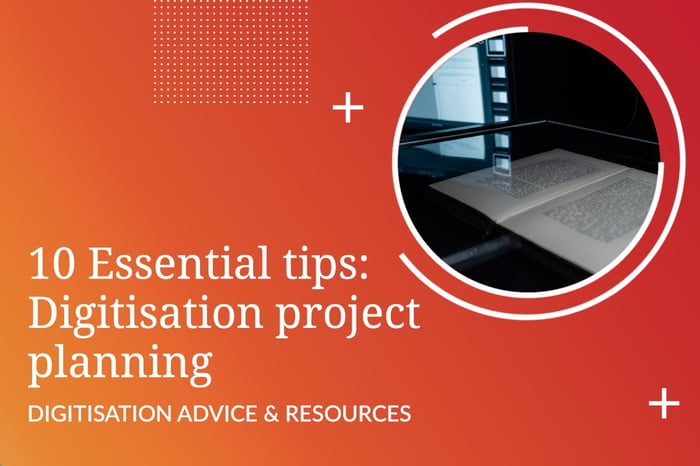Planning a digitisation project, especially a large-scale one, can be daunting but it is also the best way to avoid potential problems, allowing you to identify the most appropriate digitisation methods and achieve the best quality outputs, ensuring the project is a success.
Having worked with over 800 archivists, record managers, and curators, on all manner of digitisation projects, we have a wealth of experience in helping our clients plan and implement their goals effectively.
So we’ve taken our own industry insight, as well as the advice and guidelines offered by JISC and The National Archives, to help you better understand how to plan digitisation and achieve results:
1. Start with your goals
Though it may sound obvious, clearly defining the purpose of the digitisation project and what you aim to achieve from the outset is critical. These aims will guide virtually all other planning decisions for the project from the specific materials you choose to digitise, to designing your digitisation workflows and how you intend to offer access.
For example, it may be that you want to support conservation efforts by creating a digital version of a collection for internal staff to use, minimising the need to handle fragile analogue materials. Alternatively, you may want to publish the resource online via an online publishing platform or simply create a high resolution back up of the original materials for preservation purposes.

2. Specify who your users will be
Who are you digitising for? Considering the intended users of your digital resource, and how they will likely utilise it, will enable you to make informed decisions, such as which descriptive metadata you will capture and how you will provide access to the archive.
3. Assess the condition of the materials
It is essential to perform a condition assessment of the materials you intend to digitise during the planning stage of the project, to ascertain whether they are in a suitable state to go through the digitisation process without being harmed.
In many cases, if the items you are planning to digitise are being regularly handled, they are likely to be suitable (as long as the technicians carrying out the scanning adhere to fragile handling guidelines). However, in some cases conservation processes might need to be undertaken to stabilise or repair items before digitisation can proceed.
4. Audit your digitisation capabilities
Do you have the necessary human resources, skills, and equipment available to perform the digitisation? More specifically, do you have the resources to complete it to a sufficient quality, within the project timescale, and without harming precious material?
The answers to these questions will impact whether you decide to digitise in-house or outsource the scanning to an external digitisation specialist (see point 5).
5. Decide: in-house or outsource
Whether you digitise in-house or outsource to an external organisation will be strongly influenced by your available budget and existing capabilities for digitisation. It’s important to carry out a thorough cost-benefit analysis. This will help to establish which option will provide the best value for your project in terms of quality of image output and project turnaround time while minimising risk and financial cost.
Digitising in-house does offer more control over the project and might intuitively seem the cheapest (and therefore best) option. Indeed, it can be if your organisation already possesses scanning equipment, trained and experienced staff, and your materials are not of a particularly fragile nature. If this is not the case then digitising in-house can incur significant overhead costs as well as costs associated with staff training, reduced productivity, management time and quality checks. Potentially increased risk of damage to the materials is another factor to consider if your staff are inexperienced in digitising fragile items.
Outsourcing to an external supplier is often perceived as expensive. However an experienced premium provider will ensure quality and consistency of the digital images, as well as a timely throughput rate and turnaround due to economies of experience and specialist equipment.
In addition, the overhead costs of digitisation (power, workspace, equipment, media, staff time) are absorbed by the supplier, making your costs more transparent.
6. Plan for access
Making your digital archive an accessible resource for your target users is of course essential in order to make the project worthwhile. This can be achieved on three levels:
- By capturing metadata that will be valuable and useful to your target users. This metadata can be associated with the digital images and made fully searchable, allowing fast information retrieval and viewing of the digitised records.
- By making the digital archive available via a medium suitable for your target users. For example, if you are creating the digital archive for staff use within your organisation, this could be as simple as importing the images and metadata into your existing digital asset management system.
- By making content more widely accessible (to the public), allowing them to look up records, such as burial registers, for example. This could involve importing the images into a web content management and publishing platform, such as PastView with its dedicated search functionality and specialist management and publishing features.
Obviously the above options will have vastly different implications for your budget and your project timescales.
7. Make sure you own the copyright
Does your organisation own all of the archive items that you are planning to digitise? If not, you may need to gain permission from the owner(s) of the materials before you can legally digitise them. You will need additional permission if you plan on making the digital files available to the public online.
If you are outsourcing the digitisation, it’s also important to ensure that you will own the copyright to the digitised images once they are created and that the external supplier does not retain ownership of them. There is always help on hand and it’s prudent to look out for events and surgeries that might offer some helpful advice on where you stand.
In addition, if you intend to publish your digitised content online, you may need to plan how you will protect your own copyright, such as digitally watermarking images when displayed on the web. For further information The National Archives offers this guidance on copyright for archives.
8. Capture to standard output formats
To maximise the long-term usefulness and accessibility of your digitised images, it is recommended to capture the master images in an open source, non-proprietary format. Examples of these include TIFF, JPEG, JPEG2000, and PNG.
JISC Digital Media recommends capturing initially in uncompressed RGB Baseline TIFF format to create master versions of your images, and this is the standard format that TownsWeb Archiving captures to for our clients projects. All surrogates (such as compressed JPEGs for the web) can then be produced from these masters.

9. Run a Pilot Project
If digitising in-house, running a small scale pilot digitisation project can help test and refine your digitisation workflows, as well as provide benchmarks for throughput rate, image output quality, and staff time. These benchmarks will enable you to more accurately forecast timescales and staff overheads for budgeting purposes.
If outsourcing the digitisation, most professional suppliers will take samples of your collection to perform test scans. These will then be used to provide sample images to show the quality of the outputs and give an accurate estimate of timescales and costs.
10. Plan ongoing storage & management
We recommend storing your digital archives in a minimum of two geographically separate locations. Ordinarily this will involve holding one copy on your organisations server or local PC’s, in addition to a copy stored on an external hard drive elsewhere.
In the longer term, you will need to consider digital preservation and the potential for medium/file format obsolescence. Digital preservation is an important topic with a fast growing body of literature, far too much to cover here. You can find out more about digital preservation by visiting Preservica, one of our trusted partners.
In terms of management, it is likely that you will have an existing system that is used to organise your digital archives. However, if not there are a number of different digital archive management platforms, including TownsWeb Archiving’s own PastView system, that can make it quick and easy to maintain your content. Once again though, a cost-benefit analysis of these systems will need to be carried out to ascertain if they are suitable for your project’s budget and needs.
Would you like more digitisation planning advice?
We hope you found the above digitisation tips helpful. If you are considering a digitisation project please do not hesitate to contact us with any questions you may have. One of our digitisation consultants will be more than happy to talk you through it.
If you found this blog post helpful then you might also find our Best Practice tips for using Volunteers in Digitisation Projects an interesting read.





 USE OUR ONLINE
USE OUR ONLINE








